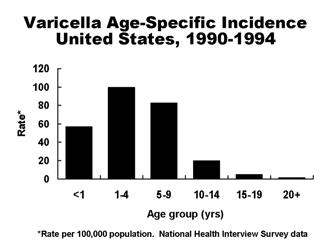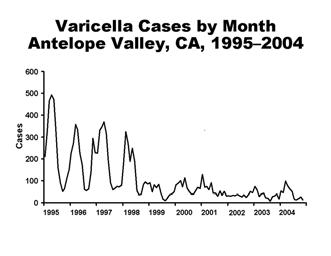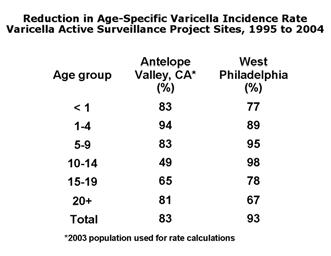Chickenpox epidemiology and demographics: Difference between revisions
Jump to navigation
Jump to search
| Line 24: | Line 24: | ||
===Prevalence=== | ===Prevalence=== | ||
The prevalence of chickenpox may be distinguished based on the pre and post vaccine eras. | |||
====Pre-vaccine era==== | |||
====Post-vaccine era==== | |||
==Gallery== | ==Gallery== | ||
Revision as of 15:21, 15 June 2017
Editor-In-Chief: C. Michael Gibson, M.S., M.D. [1] Associate Editor(s)-in-Chief: Aravind Reddy Kothagadi M.B.B.S[2]
|
Chickenpox Microchapters |
|
Diagnosis |
|---|
|
Treatment |
|
Case Studies |
|
Chickenpox epidemiology and demographics On the Web |
|
American Roentgen Ray Society Images of Chickenpox epidemiology and demographics |
|
Risk calculators and risk factors for Chickenpox epidemiology and demographics |
Epidemiology and Demographics
- Varicella is an endemic disease spread mainly by the respiratory route
- Cases are observed all through the year but most in the winter and early spring.
- In tropical regions, cases of varicella infection have been reported to be more commonly among adults than children
Age
- Varicella being one of the classical diseases of childhood, has a highest prevalence occurring between the age groups of 4 - 10 years old .
- It is highly communicable, with an attack rate of 90% in close contacts. Occurs mostly before adulthood but 10% of young adults remain susceptible. This pattern varies by regions, eg. in rural India, varicella is predominantly a disease of adults with the mean age of infection being 23.4 years which could be due to the interference by other respiratory viruses that the children are exposed to at an early age.[1]
- From generations, varicella has been a disease predominantly affecting the preschool and school-aged children. In tropical regions, the disease noticed among adults has the characteristics of the pocks being darker and the scars being more prominent than their younger counterparts.[1]
- In the U.S., 55% of chickenpox deaths are in the over-20 age group, even though they are a tiny fraction of the cases.
Prevalence
The prevalence of chickenpox may be distinguished based on the pre and post vaccine eras.
Pre-vaccine era
Post-vaccine era
Gallery
-
-
-
-
Varicella cases and states reporting, United States, 1972-1996. From Public Health Image Library (PHIL). [2]



![Varicella cases and states reporting, United States, 1972-1996. From Public Health Image Library (PHIL). [2]](/images/2/26/Chickenpox40.jpeg)